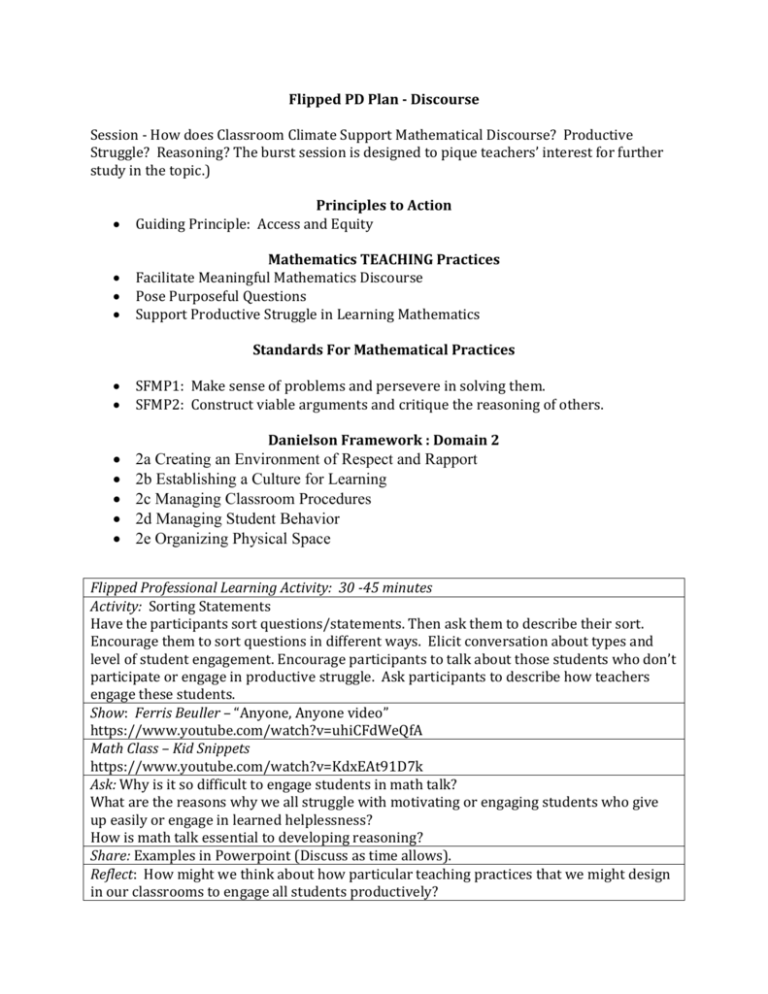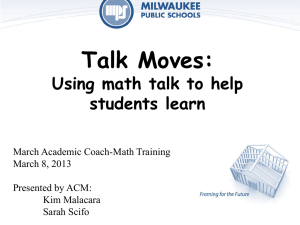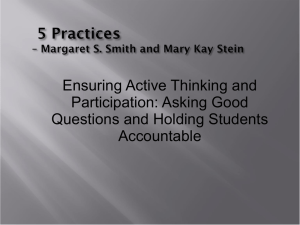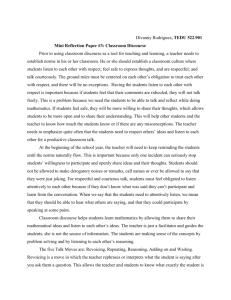Flipped PD Plan - Discourse Session
advertisement

Flipped PD Plan - Discourse Session - How does Classroom Climate Support Mathematical Discourse? Productive Struggle? Reasoning? The burst session is designed to pique teachers’ interest for further study in the topic.) Principles to Action Guiding Principle: Access and Equity Mathematics TEACHING Practices Facilitate Meaningful Mathematics Discourse Pose Purposeful Questions Support Productive Struggle in Learning Mathematics Standards For Mathematical Practices SFMP1: Make sense of problems and persevere in solving them. SFMP2: Construct viable arguments and critique the reasoning of others. Danielson Framework : Domain 2 2a Creating an Environment of Respect and Rapport 2b Establishing a Culture for Learning 2c Managing Classroom Procedures 2d Managing Student Behavior 2e Organizing Physical Space Flipped Professional Learning Activity: 30 -45 minutes Activity: Sorting Statements Have the participants sort questions/statements. Then ask them to describe their sort. Encourage them to sort questions in different ways. Elicit conversation about types and level of student engagement. Encourage participants to talk about those students who don’t participate or engage in productive struggle. Ask participants to describe how teachers engage these students. Show: Ferris Beuller – “Anyone, Anyone video” https://www.youtube.com/watch?v=uhiCFdWeQfA Math Class – Kid Snippets https://www.youtube.com/watch?v=KdxEAt91D7k Ask: Why is it so difficult to engage students in math talk? What are the reasons why we all struggle with motivating or engaging students who give up easily or engage in learned helplessness? How is math talk essential to developing reasoning? Share: Examples in Powerpoint (Discuss as time allows). Reflect: How might we think about how particular teaching practices that we might design in our classrooms to engage all students productively? What are the specific math talk moves that will engage all students? Next Steps: Individual or groups of teachers may decide to find out more about this topic and conduct an investigation during the PLC time to gain more information and design a project. Want to find out More? Invite participants to Flipped PD Opportunities: PLC time is spent investigating the topic with the coach providing support and answering questions. Examples of additional resources and materials are included below. Additional Materials Resources NCTM Research Brief – Discourse Briefs/research%20brief%2020%20-%20strategies%20of%20discussion.pdf Teaching Channel –Benefits of Talk Moves https://www.teachingchannel.org/videos/student-participation-strategy Teaching Channel – Describes specific Talk Moves https://www.teachingchannel.org/videos/developing-communication-skills Math Solutions – The Tools of Classroom Talk – Chapter 2 http://www.mathsolutions.com/documents/9780941355537_CH2.pdf 5 Practices for Orchestrating Productive Mathematics Discussion http://www.amazon.com/Practices-Orchestrating-Productive-MathematicsDiscussions/dp/1452202907 Possible Project Ideas Self-evaluate the classroom discourse practices (student interviews, video) Design lessons with specific Math Talk Moves Have coach observe lesson and provide feedback Provide a demonstration lesson using math talk moves Redesign Classroom Physical Space Math Talk Moves Revoicing: When revoicing a student comment or thoughts, the teacher repeats what a student has said, then asks the student to respond and verify whether or not the teacher's revoicing is correct. It is important that the student’s language and communication is maintained. Simply saying it “better” or in “teacher language” is not the idea. The goal is to maintain the integrity of the student comment. An example of the teacher prompt might include "Are you saying...?" Asking students to restate someone else's reasoning: Students understand that they may be asked to restate another student’s comment. However, this is not meant to be a punitive strategy used to manage behavior by “catching” those students are perceived to be not listening. The teacher asks one student to repeat or rephrase what another student has said. The teacher then asks the original student if the student was able to correctly describe the comment. An example of the teacher prompt might include "Can you repeat what he just said in your own words?" Asking students to apply their reasoning to someone else's reasoning: Students must be able to contribute to others’ reasoning by thinking about how their thinking might relate or contradict to student ideas and contributions. Students can clarify their own reasoning or expand on other’s thinking. An example of the teacher prompt might include “Do you agree or disagree and why?" Prompting students for further participation: Students may often expand on other’s ideas by giving another example or deepening the connection through further discussion. This also extends the classroom discussion because students must listen and think about how they can extend other’s ideas. In this example the teacher asks for further commentary by asking "Would someone like to add on or given another example?" Using wait time: Students who process differently might not get to engage in the fast pace of the teacher/student question and answer classroom dialogue. In order to involve more students in classroom conversation and mathematical sense-making, the teacher waits at least ten seconds for students to think before calling on someone for an answer. In this example, the teacher might say, “Let’s all think about a response to this question. I will give you a signal when it is time to raise your hands and share your thoughts.”









